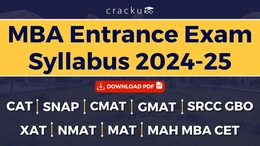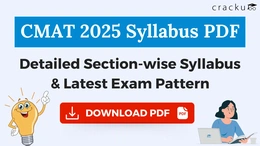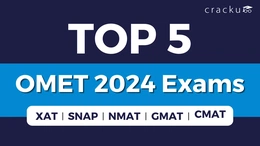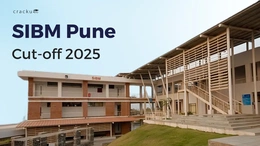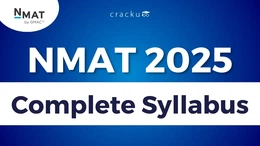OMET Syllabus 2025: The CAT is the most challenging and widely acknowledged MBA entrance exam in India. The CAT exam consists of three sections: VARC, QA, and DILR. Over 3 lakh MBA aspirants appear for the CAT every year. Considering the wide acceptability of the CAT, which is increasing every year - it can be said that CAT is the most important MBA exam in India. Checking with the CAT Syllabus will help you understand the sections that are different from OMETs.
However, different exams tests different skills. "OMET" is an umbrella term for Other Management Entrance Tests, which include but aren't limited to - XAT, SNAP, NMAT, MAT etc.
The OMET(s) syllabus covers a wide range of topics intended to assess a students' preparation to pursue an MBA. Significantly, the MBA entrance exam syllabus addresses major aspects of business and management education by conducting an exam that tests a variety of skill sets including quantitative aptitude, verbal ability, logical reasoning, and general awareness.
In this blog, we shall cover some very important OMETs and their syllabus.
OMET Exam Syllabus PDF
Each OMET exam has a different syllabus covering areas like Quantitative Aptitude, Verbal Ability, Logical Reasoning, Data Interpretation, and General Awareness. To help you prepare better, we’ve brought the syllabus for major OMETs like XAT, SNAP, NMAT, and more. You can download the OMET exam syllabus PDFs for detailed topic breakdowns and structure.
Below is the list of OMET exams along with their respective syllabus PDFs for 2024:
| Exam Name | OMET Exam Syllabus PDF |
|---|---|
| XAT | XAT Syllabus PDF |
| SNAP | SNAP Syllabus PDF |
| NMAT | NMAT Syllabus PDF |
| MAT | MAT Syllabus PDF |
| CMAT | CMAT Syllabus PDF |
XAT Exam Syllabus 2025
| Total Questions | Total Marks | Sections | Questions per Section | Marking Scheme | Duration |
| 101 | 101 | Verbal and Logical Ability Quantitative Ability & Data Interpretation Decision Making General Knowledge | Verbal and Logical Ability - 26 Quantitative Ability & Data Interpretation - 28 Decision Making - 22 General Knowledge - 25 | +1 Mark for every correct answer -0.25 for every incorrect answer -0.10 marks will be deducted for 8 consecutive or more unattempted questions | 175 Minutes |
The XAT exam can be considered the toughest management exam in India. The XAT is excruciatingly long - 170 minutes - and the VARC portion which is Verbal and Logical Ability is significantly tougher than the CAT. The passages are denser, the questions are tricker and have more variety as compared to the XAT.
The benefit of the XAT is the absence of the DILR section but instead of that we have the Decision Making section which is a nightmare for most students and a piece of cake for others. In a DM section, you are given certain caselets and you have to choose the right course of action to mitigate or solve that problem, as a manager.
The QA section of the XAT is almost equal to the QA section of the CAT, except that the questions are much longer (so as to confuse the aspirants)
| Verbal and Logical Ability | Decision Making | Quantitative Ability & Data Interpretation |
Fill in the Blanks with Correct Words Jumbled Paragraphs Paragraph Completion Reading Comprehension Correction of Errors Vocabulary based questions | Caselets Premises Conditions and Grouping | Arithmetic Number System Modern Math Algebra Data Interpretation Geometry |
NMAT Exam Syllabus 2025
| Total Questions | Total Marks | Sections | Questions per Section | Marking Scheme | Duration |
| 108 | 360 | Language Skills Quantitative Skills Logical Reasoning | 36 marks each | Correct: +3, No Negative Marking | 120 minutes |
NMAT exam is a national-level entrance test that is much known for its middle-level difficulty level, where it does justice to a large pool of MBA aspirants. The paper comprises three sections: Language Skills, Quantitative Skills, and Logical Reasoning. Each section has individual timing. The test paper offers infinite chances for the candidate to choose the order of sections in the test paper and score well.
The test is adaptive in nature. NMAT is unique among all the admitted tests, where the computer changes the level of difficulty of the candidate. It allows for a tailored testing experience with lower anxiety, as perceived over other MBA entrance exams—such as CAT or XAT.
One of the prime advantages of NMAT is that it allows candidates more than one testing window and, hence, attempts whereby the score can be bettered. The NMAT also gives you the advantage of deciding your order of attempt. This allows you to focus on your strength and plan accordingly.
| Language Skills | Quantitative Skills | Logical Reasoning |
Synonyms Antonyms RC Passages Idioms Tenses | Arithmetic Number System Modern Math Algebra Data Interpretation | Figure based reasoning Quantitative Reasoning Coding Decoding Verbal Reasoning |
SNAP Exam Syllabus 2025
| Total Questions | Total Marks | Sections | Questions per Section | Marking Scheme | Duration |
| 60 | 60 | General English Data Interpretation & Data Sufficiency Analytical & Logical Reasoning | General English -15 Data Interpretation & Data Sufficiency- 20 Analytical & Logical Reasoning-25 | +1 for every correct answer -0.25 for every incorrect answer | 60 minutes |
SNAP Exam SNAP stands for Symbiosis National Aptitude Test, which is conducted at a national level by Symbiosis International (Deemed University) as an entrance exam to different MBA programs offered by constituent colleges. The SNAP exam is usually famous for its moderate to high difficulty, especially the Logical Reasoning part, which is said to be highly challenging.
Needless to say, one key takeaway from the SNAP test is that it focuses on both speed and accuracy; at the same time, the SNAP test proper lasts an hour, hence requiring swiftness and precision from the test taker. SNAP scores are accepted only by the 15 Symbiosis Institutes, which are among the top-ranked MBA colleges in India. Also, SNAP allows multiple test attempts, and the best score will be considered for admission, which gives better opportunities to secure a seat in institutes every year.
| Quantitative, Data Interpretation & Data Sufficiency | General English: Reading Comprehension, Verbal Reasoning, Verbal Ability | Analytical & Logical Reasoning |
Arithmetic Number System Modern Math Algebra Data Interpretation | Sentence Correction Synonyms and Antonyms Jumbled Paragraphs Fill in the Blanks | Coding - Decoding Syllogisms Visual Reasoning Mathematical Reasoning |
MAT Exam Syllabus 2025
| Total Questions | Total Marks | Sections | Questions per Section | Marking Scheme | Duration |
| 200 | 200 | Language Comp., Int. & Critical Reasoning, Data Analysis & Sufficiency, Math Skills, Indian & Global Environment | Each Section: 40 marks | Correct: +1, No Negative Marking | 150 minutes |
The Management Aptitude Test (MAT) is a commonly taken entrance test, carried under the aegis of the All India Management Association (AIMA) for degree and allied programs under the domain of management. MAT test is moderate with test items divided into five sections: Language Comprehension, Mathematical Skills, Data Analysis & Sufficiency, Intelligence & Critical Reasoning, and Indian & Global Environment. The test assesses the analytical, reasoning, language abilities, and general awareness of a candidate.
The most useful feature of MAT exam is its flexibility, whereby the test is conducted four times in a year and in various modes such as internet-based, computer-based, and remote proctored online. The candidates could choose the form that suited them best in terms of convenience. The B-schools in India that accept the MAT scores are many, providing a wide range of opportunities to aspirants. Also, it is the frequency and predictable pattern of the examination that makes it a favorite with candidates aspiring to join management programs.
| Language Comprehension | Mathematical Skills | Data Analysis & Sufficiency | Intelligence & Critical Reasoning | Indian & Global Environment |
|
|
|
|
|
CMAT Exam Syllabus 2025
| Total Questions | Total Marks | Sections | Questions per Section | Marking Scheme | Duration |
| 100 | 400 | Quant. Techniques & Data Interpretation, Logical Reasoning, Language Comp., General Awareness, Innovation & Entrepreneurship | Each Section: 20 marks | Correct: +4, Incorrect: -1 | 180 minutes |
CMAT Exam is a national-level entrance test that is conducted by the National Testing Agency, commonly known as NTA. The CMAT score allows admissions in Management Institutes offering MBA and PGDM programs. Being at a moderate level of difficulty, the test is well-known among candidates for the large number of applicants it receives. CMAT is segregated into five sections: Quantitative Techniques & Data Interpretation, Logical Reasoning, Language Comprehension, General Awareness, and Innovation & Entrepreneurship. Each section carries equal weightage, testing a candidate's analytical, verbal, and general knowledge skills.
The score obtained via CMAT allows a candidate the opportunity to participate in being accepted by more than 1,000 AICTE-approved institutions across India, hence giving wider exposure to management education. Added to this, since it is held in one test window, it makes the admission process less cumbersome for many students.
| Quantitative Techniques & Data Interpretation | Logical Reasoning | Language Comprehension | General Awareness | Innovation & Entrepreneurship |
|
|
|
| Questions related to innovation, entrepreneurship and start up business |


